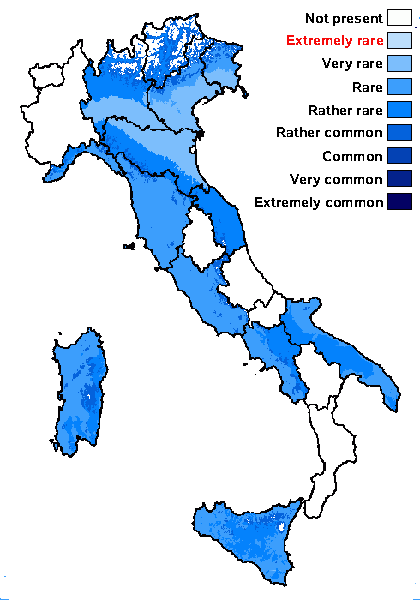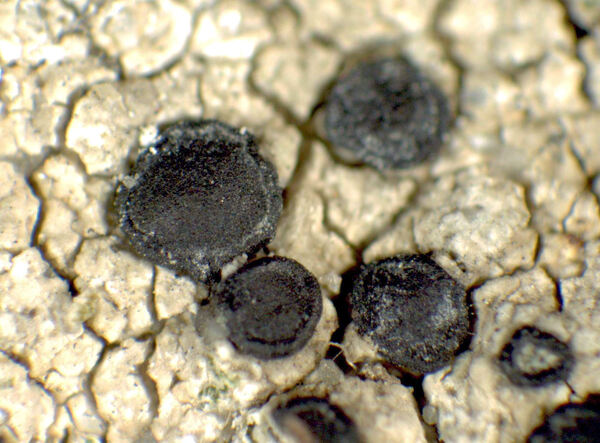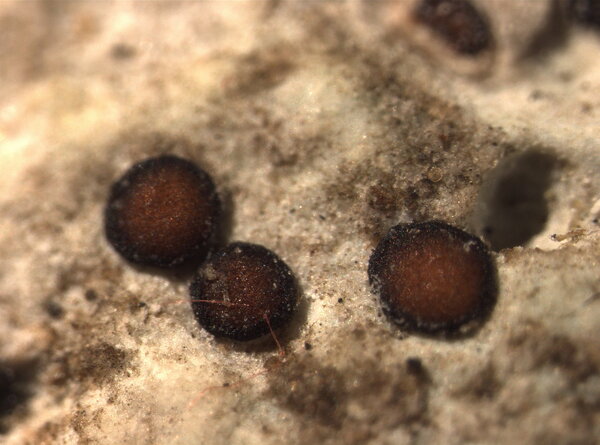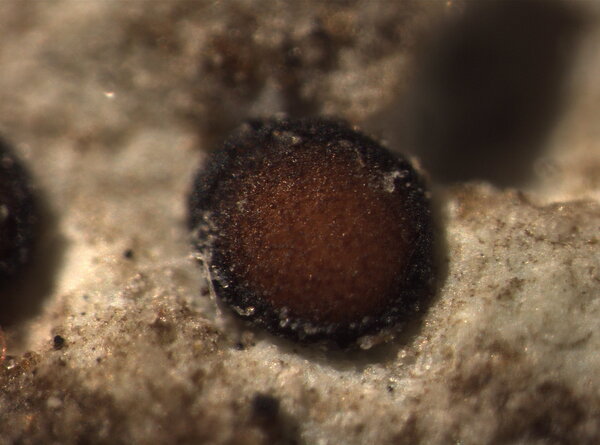Clauzadea chondrodes (A. Massal.) Hafellner & Türk
Clauzade & Cl. Roux ex Hafellner & Türk, Stapfia, 76: 151, 2001. Basionym: Biatora chondrodes A. Massal. - Symmicta Lich.: 39, 1855.
Synonyms: Biatora cyclisca A. Massal.; Clauzadea cyclisca (A. Massal.) V. Wirth; Lecidea chondrodes (A. Massal.) Malbr.; Lecidea cyclisca (A. Massal.) Malbr.; Lecidea savonensis B. de Lesd.; Protoblastenia chondrodes (A. Massal.) Zahlbr.
Distribution: N - VG (Meyer 2002), Frl, Ven (Lazzarin 2000b, Meyer 2002, Watson 2014), TAA (Meyer 2002), Lomb, Emil (Fariselli & al. 2020), Lig (Meyer 2002). C - Tosc, Marc (Nimis & Tretiach 1999), Laz, Sar (Meyer 2002). S - Camp (Aprile & al. 2003b, Garofalo & al. 2010), Pugl, Si (Grillo 1998, Meyer 2002, Grillo & Caniglia 2004).
Description: Thallus crustose, episubstratic to hemiendosubstratic, usually c. 1 mm thick, continuous, white, bluish white, or ochre-coloured, sometimes inapparent, often greenish or blue-green when wet, sometimes surrounded by a white prothallus. Medulla I-, filled with crystals of calcium oxalates and overlain by a distinct epinecral layer of dead, compacted cells. Apothecia lecideine to biatorine, round to irregular in outline, (0.3-)0.5-1.2(-1.5) mm across, slightly immersed in the thallus to subsessile, leaving distinct depressions when falling off, with a black (reddish-brown when moist), usually flat disc, and a very thin, soon excluded proper margin. Proper exciple dark red-brown in outer part, almost colourless within, of more or less radially arranged hyphae, 20-110 µm thick laterally, much thinner at base; epithecium ochraceous to reddish brown; hymenium colourless, 65-132 µm high, I+ reddish and partly pale blue; paraphyses sparingly branched and anastomosing, septate but not moniliform, 4-5.5 µm thick at mid-level, scarcely swollen at apex; hypothecium narrowly stem-like, deeply immersed, colourless to pale brown in upper part, at least partially I+ blue. Asci 8-spored, elongate-clavate, with a thin, outer amyloid layer and a thickened tholus penetrated by a pore, the sides of which stain K/I+ deep blue, Porpidia-type. Ascospores 1-celled, hyaline, ellipsoid, (8-)13-18(-22) x 5-7(-10) µm, with a > 1 µm thick, gelatinous perispore when young, the wall of old spores not warted. Pycnidia black, laminal, immersed. Conidia bacilliform, 4-6 x 1-2 µm, with apical and lateral conidiogenesis. Photobiont chlorococcoid. Spot tests: thallus K-, C-, KC-, P-, UV-. Chemistry: without lichen substances.Note: a mainly temperate lichen found on limestone and dolomite, on surfaces with short water seepage after rain, often with colonies of cyanobacteria, but avoiding very dry situations; widespread and perhaps more common in Italy than the relatively few records would suggest.
Growth form: Crustose
Substrata: rocks
Photobiont: green algae other than Trentepohlia
Reproductive strategy: mainly sexual
Commonnes-rarity: (info)
Alpine belt: absent
Subalpine belt: absent
Oromediterranean belt: absent
Montane belt: rather common
Submediterranean belt: rather rare
Padanian area: very rare
Humid submediterranean belt: rare
Humid mediterranean belt: rare
Dry mediterranean belt: rare

Predictive model
Herbarium samples
Growth form: Crustose
Substrata: rocks
Photobiont: green algae other than Trentepohlia
Reproductive strategy: mainly sexual
Commonnes-rarity: (info)
Alpine belt: absent
Subalpine belt: absent
Oromediterranean belt: absent
Montane belt: rather common
Submediterranean belt: rather rare
Padanian area: very rare
Humid submediterranean belt: rare
Humid mediterranean belt: rare
Dry mediterranean belt: rare

Predictive model
| Herbarium samples |
 INDEX FUNGORUM
INDEX FUNGORUM
 GBIF
GBIF
 DOLICHENS
DOLICHENS






